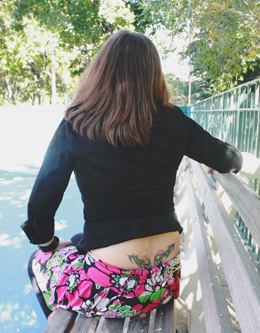Ladies and the Tramp Stamp
Call them “handlebars,” “California license plates” or “pull out targets,” those ubiquitous tattoos above the butt have aroused a backlash. But what do the jokes really say about women and their bodies?
Some mothers and daughters make pancakes together. Some watch Dancing with the Stars. But Donna and Katrina went for matching mother-daughter tattoos—on their lower backsides. That mid-August day in 2002 seemed like harmless fun when the family packed up their RV and headed forty-five minutes from their home in Carlstadt, to attend one last barbeque of the summer. Donna steered the RV, following her husband, Mike, as he sped down the highway on one of his three motorcycles. Around noon, the s arrived at a friend’s lush property tucked within the forest.
Before them stood a log cabin assembled from a made-to-order kit. On the house’s deck, a leather-clad crowd huddled around the simmering grill as children chased each other through a maze of Harleys. Americana on acid. Katrina and her three brothers cannonballed into the backyard pool while some of their friends raced dirt bikes. The 60-person party resembled a Boy Scout troop reunion if all the Tiger Cubs, Bobcats, Wolfs, Bears and Webelos grew up and joined the Hell’s Angels. Two tattoo artists sterilized their equipment in a white tent, ready to touch up any of the bikers’ faded ink. Soon the sun began to set, its rays ricocheting off the Appalachians towering overhead.
Donna, then 46, always wanted a tattoo. After scanning through the artists’ tomes of previous work, she convinced her daughter to get the same kind as her mother—like a pair of outstretched bat wings punctured with hearts. Across her lower back, where Jessica Alba, Christina Aguilera, Victoria Beckham, Angelina Jolie, Norah Jones, Anna Kournikova and Eva Longoria all now flaunt lasting skin decals. This was several years before a woman’s lower back tattoo elicited eye rolls and society’s typecasting as one of those girls. It was long before the cultural backlash, sneering remarks, and today’s inescapable catchphrase—the “tramp stamp.”
Just after 10 p.m., Katrina changed into her fleece blue and purple pajamas with smiley face stars, and sat down backwards on a folding metal chair.
“You’re 16, right?” one of the tattoo artists inquired suspiciously.
“Yep,” 15-year-old Katrina responded. Her mom nodded in agreement.
Then the needle pricked Katrina at the base of her spine.
“It was like if you took a pin and jabbed it in my skin, and dragged it across my back for two and a half hours,” Katrina says. “People tell you it’s going to get numb—it’s a total fucking lie.”
As Katrina gnawed on a Pepsi can to distract her from the pain, the second artist began the same process on Donna. Mike , a devout patron of the Manhattan bar Hogs & Heifers (he stopped cutting his hair in the 80s), still had no tattoos of his own. Now he gaped at the two women he loved most while they got theirs: a permanent rite of passage into the biker kingdom.
When asked if she ever regretted her tattoo, Katrina responded, “I never had buyer’s remorse, like, ‘Oh my God, I can’t believe I just did that!’” But back home her boyfriend, Rob, called her tattoo “disgusting,” and they broke up a week later.
For Katrina and her mom, their “backcents” serve as fun reminders of their bonding experience. Rob was one of many disdainers who believe that females with such tattoos use their bodies as billboards, broadcasting their kinky sexual practices to the world. If a man sees a woman’s “tramp stamp,” he might instinctively multiply her imaginary number of sexual partners by 10. Minimum.
Today, Katrina’s wardrobe gives no hint of promiscuity: seafoam sweatshirt with lettering inside the hood, grey t-shirt supporting her Becton High School football team, army green capris, plaid Birkenstock knock-offs from Target and a Stephen Colbert “Wrist Strong” bracelet. Her flat-ironed brown hair complements her minimally made-up face.
“The fact that [Rob's] girlfriend had one on her back was so skanky to him,” Katrina said, sipping her hazelnut coffee at The Grey Dog, a café blocks from her NYU classrooms. Next year she will graduate with a degree in Childhood and Special Education, licensing her to teach elementary school.
Yet conventional frat boy wisdom emphasizes that the bigger a girl’s lower back tattoo, the bigger whore she is. Men who use “tramp stamp” seem to love it like half-off Heinekens. Not only do the words rhyme, but these guys say the term perfectly describes the women possessing this specific tattoo. Until a few years ago, men kept the label to themselves; the password to a he-man, woman-bangers club. But the catchphrase soon gained popularity among the ladies, too, both the have-tats and the have-nots.
Women use the saying when gossiping to single out such anatomy-embellishing peers as sluts. Some of the “stamped” make fun of themselves for acting solely on a youthful impulse; others advocate reclaiming “tramp” so that men can no longer employ it as an insult. A large portion of the tattooed women interviewed for this article still bristle at the “tramp stamp” connotation, which they are now all too familiar with after newspaper writers picked up on the phrase two years ago, giving clout to a risqué, once obscure joke. In recent months, Toys R Us stores nationwide pulled child-size “lower back tattoos” from their sticker machines after parents complained. Thus the debate that began in dive bars went mainstream over whether a “tramp stamp” warrants its reputation and if youngsters should have them. The question reignites lingering issues about double standards, sexual empowerment and “good girls” versus “bad girls” – all converging around a tattoo.

